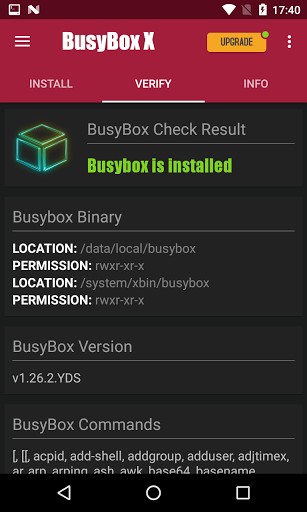
- What is busybox for android install#
- What is busybox for android software#
- What is busybox for android code#
What is busybox for android software#
If you want to rely on BusyBox, it’s best to start with a distribution that uses it and then layer your other software on top. Your distribution will usually refuse to uninstall this package as it could render the system inoperable if init is removed. Distro-specific commands and packages are often hardwired to expect the coreutils utilities to be available. On most Linux distributions you can’t completely replace coreutils with BusyBox. You can run a specific command by adding it after the image name: docker run -it -rm busybox mkdir demoīusyBox also has a JavaScript emulator that lets you try the utilities in your web browser. If you’ve got Docker installed, this will drop you into BusyBox’s shell implementation. This ensures the BusyBox version of the command will be used instead of the version in your shell’s default path.Īnother way to try BusyBox is via its official Docker image: docker run -it -rm busybox Use your package manager to add busybox, then append your chosen command to the busybox binary to run an applet: busybox mkdir test
What is busybox for android install#
You can install BusyBox without replacing your current utilities. Distributing a modified BusyBox binary frees up a few more KBs of disk space which can be a significant saving. An IoT product may only need a handful of critical utilities to provide its functionality. Vendors of embedded devices also benefit from BusyBox’s modular nature.

As BusyBox offers good compatibility with other implementations, and is licensed under the GPL, it’s usually the go-to option for environments needing a lightweight set of utilities.
What is busybox for android code#
It reduces redundancy by allowing all the commands to share common code without storing standalone libraries on disk. Shipping a single all-in-one binary is more efficient. Each of these settings is characterized by a need to run core userland tools within a heavily resource-constrained environment. You’ll find it on your network router, smart TV, modern car, and IoT devices. It’s used by minimal operating systems such as Alpine as well as specialized scenarios like embedded devices and mobile shells.Ĭhances are good that a Unix-derived device that’s not running a conventional OS distribution will be using BusyBox. Where Is BusyBox Used?īusyBox can be found wherever disk usage is a concern. This is one of the trade-offs of BusyBox’s streamlined nature. You might find some missing flags or behavioral differences in uncommon situations. You could adopt BusyBox as a lightweight alternative to a regular init or systemd daemon.Īs BusyBox is intentionally minimal, not every command implements all the features of its GNU counterpart. That extends to a minimal init implementation that’s capable of running as process ID 1 and supporting system services. You can check what’s available in your installation by running busybox with no arguments.Īs BusyBox was created to power tiny bootable systems, it covers everything needed in userland to start and administrate a POSIX system. Applets are removable so the binary size can be shrunk even further. Commands are implemented as “applets” which are combined into a functioning BusyBox distribution. You can transparently use commands like mkdir, passwd, ps, tar, and wget once BusyBox is installed.

Many Linux distributions deliver these commands via GNU’s coreutils but others ship BusyBox instead. Although userland tools like ls and cat are ubiquitous, they actually reside in a separate utility package that’s independent of your shell. What Does BusyBox Include?īusyBox provides the everyday convenience commands that often feel like they’re part of your shell. Bundling commands together into one binary reduces overheads and permits code-sharing between seemingly independent applications. It was created in 1995 with the intention of making a bootable system fit onto a single floppy.

The complete distribution has almost 400 of the most common commands.īusyBox is open-source and licensed under the GPL. This makes it ideal for resource-constrained environments such as embedded devices. Fatmawati achmad zaenuri/īusyBox is a collection of core Unix utilities packaged as a single binary.


 0 kommentar(er)
0 kommentar(er)
